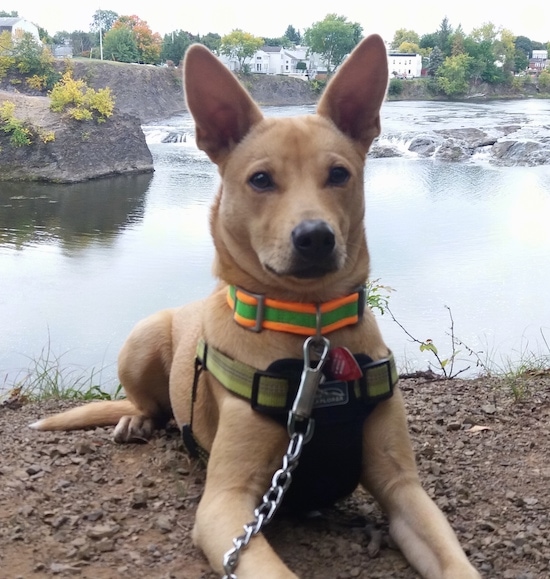
Cali the Carolina Dog (American Dingo) at 7 months old
kar-uh-lahy-nuh dawg
The Carolina Dog is very similar in appearance to a small Dingo. The distinctive features of this breed are those which have been valuable to its survival in the swamps and forests of the South. The Carolina Dog has a medium length straight back, well-developed chest and well tucked-up belly, giving it a slight resemblance to the sighthound breeds. It has a long neck, wedge-shaped head with powerful jaws, almond-shaped dark eyes with a soft, intelligent, yet alert expression, and large, erect high-set ears which are very mobile. The Carolina Dog is very well-muscled and powerful for its size, showing strong, free and agile movement with a lot of drive and is very flexible and able to turn instantly. Distinctive to the breed is the “fish-hook” tail, carried in various positions according to the mood of the dog, but never slack or loose. The skin is tight and the coat is short but thick with a dense undercoat in season; there is a profusion of longer guard hairs on the neck, withers and back that may be erect when the dog is aroused. The color of the Carolina Dog is distinctive, usually a deep red ginger with pale buff markings on the shoulders and side of the muzzle, and paler shadings on underside, throat and chest. Lighter shades of red and cream are not uncommon. Darker shading over the back, loins and tail is permitted.
The following are the color variations from light to dark. Predominant color listed:
White with spots
Tan, beige, desert sand, yellow
Orange, ginger red
Red sable
The preferred color is deep red ginger with pale buff markings over the shoulders and along the muzzle. Variations in color, grading from straw colored through wheaten to pale yellow or buff are also acceptable, but never all white. The Carolina Dog must look like a natural animal, capable of surviving in the wild, hardy, strong and capable. It is not trimmed.
The Carolina Dog is a pariah dog. ("Pariah dog" is a general name in India for the half-reclaimed dogs that swarm in every village, owned by no one in particular, but ready to accompany any individual on a hunting expedition.) The Carolina Dog is one of the very few breeds existing today that is truly a primitive dog, a result of natural selection for survival in nature, and not of selective breeding. Wild specimens are still known, so this is not a completely domesticated canine. This dog that has survived as a free living animal in the swamps, savannahs, and forests of South Carolina and Georgia for thousands of years has also proven to be highly adaptable and amenable to domestication, and an excellent pet. Many dogs are known to be extremely shy around people and dislike a lot of handling unless socialized at a very young age. With proper socialization, they are proven to be loyal companion dogs. Many of the characteristics of the natural dog that are predominant in the Carolina Dog contribute to his ability to adjust well to being a loving pet. The Carolina Dog enjoys and needs to be part of a pack, and thus integrates very well into the family framework. He is a gentle, social dog, and bonds very well with children, enjoying play and activities with them. The Carolina Dog is very clean by nature and is easy to housebreak. He is intelligent and responsive and learns easily and is not destructive. Not aggressive by nature but with a well-developed hunting instinct, the Carolina Dog will get along with other animals if introduced to them at a young age. Like the other types of pariah dog, the Carolina Dog is quite independent. If you are to keep one of these dogs as a family pet, one needs to achieve pack leader status. It is a natural instinct for a dog to have an order in their pack. When we humans live with dogs, we become their pack. The entire pack cooperates under a single leader. Lines are clearly defined and rules are set. Because a dog communicates his displeasure with growling and eventually biting, all other humans MUST be higher up in the order than the dog. The humans must be the ones making the decisions, not the dogs. That is the only way your relationship with your dog can be a complete success. He is suspicious and may be somewhat shy to strangers and in unfamiliar surroundings or circumstances. This is not a dog that is outgoing and friendly to everyone, but rather is devoted to his own “pack.” They enjoy hunting small game, a task they do with grace and quickness. The Carolina Dog could almost pass for a larger size Dingo. Like the Dingos and pariahs before them, they have strong herding instincts. Carolina Dogs have a tendency to howl at certain noises.
Height: 17 - 24inches (45 - 61 cm)
Weight: 30 - 44 pounds (15 - 20 kg)
--
The Carolina Dog is not recommended for apartment life. They do best with plenty of space around them. They are still not fully domesticated. They can live outdoors provided it is not too cold. They adapt well to hot, sunny climates.
The Carolina Dog should be taken for a daily, long walk. While on the walk it is very important that the dog is made to heel beside or behind the human while on a leash, as in the dog's mind, the leader leads the way.
About 12-14 years.
About 3 to 6 puppies
The coat of the Carolina Dog is easy to groom and practically takes care of itself. It will benefit from an occasional brushing. Bathe only when necessary.
Carolina Dogs were Indian dogs and were the first domesticated dog of the Americas. The Carolina Dog comes out of the American Deep South and is thought to be a direct descendant of the ancient pariah dogs that accompanied Asians across the Bering Strait land bridge 8,000 years ago. A number of such pariah types exist in the USA. The Carolina Dog was discovered and named by Dr. I. Lehr Brisbin, Jr., a biology professor at the University of Georgia, at the United States Department of Energy's Savannah River site in South Carolina. This is a remote area from which the public has been excluded, and wild dogs that have lived there for centuries have had little opportunity to breed with domestic dogs. Brisbin noted that these dogs were almost identical in looks to the Dingo. Other scientists observed that the Carolina's bone structure was very similar to the remains of the neolithic dog bones from Native American burial sites thousands of years old. Ecologists in the South, including Dr. I. Lehr Brisbin, Jr., are searching for pure specimens still in the wild swamps and piney woods of the Savannah River basin. Pups are occasionally placed with selected families to be raised and trained as companions and hunters of small game. Brisbin hopes that by researching the Carolina Dog, today's dogs can be better understood. Many of these dogs were favored by Indians and used for various tasks such as herding. The Kentucky Shell Heap Dog and the Basketmaker Dog are examples of ancient pariahs on the North American continent. Down South, the Carolina Dog is affectionately named "Old Yaller" because of his yellow color.
Southern
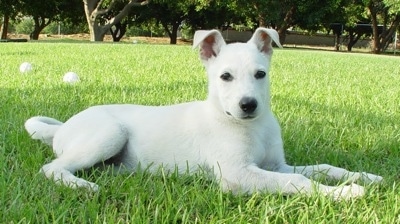
"Pictured is my 11-week-old Carolina Dog puppy, Sophia. She flew from a farm in South Carolina to San Diego, then I picked her up and drove to Gilbert, Arizona (too hot to fly into Phoenix for pets), where she now lives.",
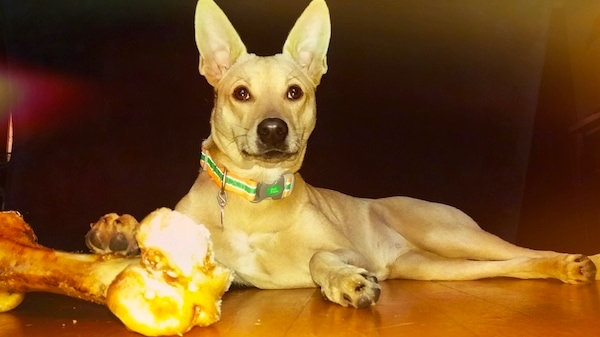
Cali the Carolina Dog (American Dingo) at 7 months old—"Cali is a rescue from a kill shelter in Arkansas. This little ball of energy and effection was born on Valentine's Day. She weighed 4lbs when we got her at 4 months. She weighed 25lbs at 7 months old. She lives in Upstate New York in her forever home with her two proud parents. She is a very unique, talented, multi faceted dog with a mind of her own. She will do just about anything for a treat and at 7 months already knows how to sit, stay, give paw, high five "both paws" lay down, fetch and return, crate trained, rides on my shoulder and loves car rides more than anything. She is extremely loyal to the family and rarely leaves my side. Cali gets along with other dogs and people, although curious of strangers at first she warms up quickly. So far Cali has lived an adventurous lifestyle as she has gone on a 7 day camping trip in a tent, gone rafting down several rivers, been on atleast 12 mountain hikes and clocked atleast 3000 miles with her head out the passenger window."
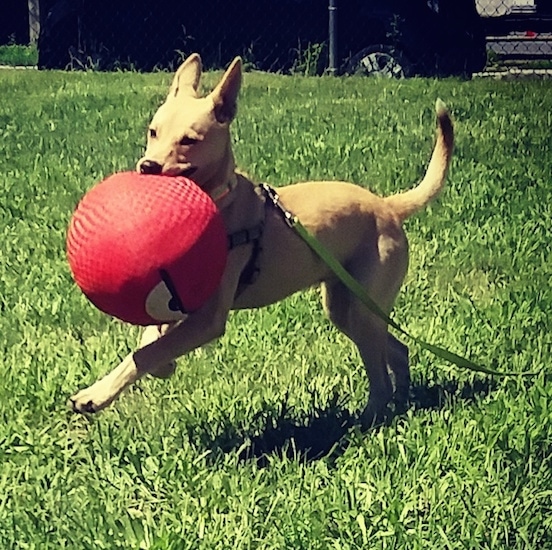
Cali the Carolina Dog (American Dingo) at 7 months old loving her big red ball.
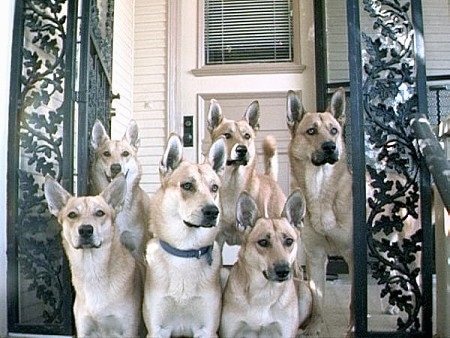
Photo courtesy of Susan Anthony, California-Carolina Dogs
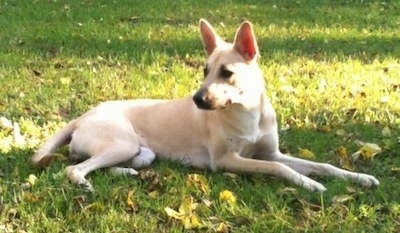
Sage the Carolina Dog at 1 1/2 years old

Sage the Carolina Dog as a puppy
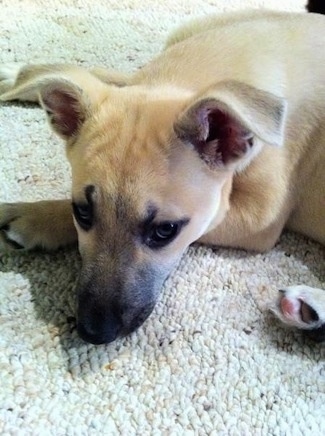
Sage the Carolina Dog as a puppy
Marlowe the Carolina Dog puppy at 6 weeks old—"Note the dark coat and floppy puppy ears."
Marlowe the Carolina Dog puppy at 3 months old—"Notice the process of the ears becoming upright. Marlowe's right ear would stand up, then flop, then stand up again over the course of a few months until it finally decided to stay put. Note his coat is much lighter—but at this point, his tail was still dark (the color change worked its way down his body—very cool.)"
Marlowe the Carolina Dog full grown at about 1½ years old—"The ears are up permanently at this point, and his coat is fully lightened."